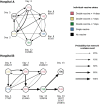Transmission of B.1.617.2 Delta variant between vaccinated healthcare workers
- PMID: 35729228
- PMCID: PMC9212198
- DOI: 10.1038/s41598-022-14411-7
Transmission of B.1.617.2 Delta variant between vaccinated healthcare workers
Abstract
Breakthrough infections with SARS-CoV-2 Delta variant have been reported in doubly-vaccinated recipients and as re-infections. Studies of viral spread within hospital settings have highlighted the potential for transmission between doubly-vaccinated patients and health care workers and have highlighted the benefits of high-grade respiratory protection for health care workers. However the extent to which vaccination is preventative of viral spread in health care settings is less well studied. Here, we analysed data from 118 vaccinated health care workers (HCW) across two hospitals in India, constructing two probable transmission networks involving six HCWs in Hospital A and eight HCWs in Hospital B from epidemiological and virus genome sequence data, using a suite of computational approaches. A maximum likelihood reconstruction of transmission involving known cases of infection suggests a high probability that doubly vaccinated HCWs transmitted SARS-CoV-2 between each other and highlights potential cases of virus transmission between individuals who had received two doses of vaccine. Our findings show firstly that vaccination may reduce rates of transmission, supporting the need for ongoing infection control measures even in highly vaccinated populations, and secondly we have described a novel approach to identifying transmissions that is scalable and rapid, without the need for an infection control infrastructure.
© 2022. The Author(s).
Conflict of interest statement
The authors declare no competing interests.
Figures



References
-
- Shrotri M, Krutikov M, Palmer T, et al. Vaccine effectiveness of the first dose of ChAdOx1 nCoV-19 and BNT162b2 against SARS-CoV-2 infection in residents of long-term care facilities in England (VIVALDI): A prospective cohort study. Lancet. Infect. Dis. 2021;21(11):1529–1538. doi: 10.1016/S1473-3099(21)00289-9. - DOI - PMC - PubMed
Publication types
MeSH terms
Supplementary concepts
Grants and funding
LinkOut - more resources
Full Text Sources
Medical
Miscellaneous

